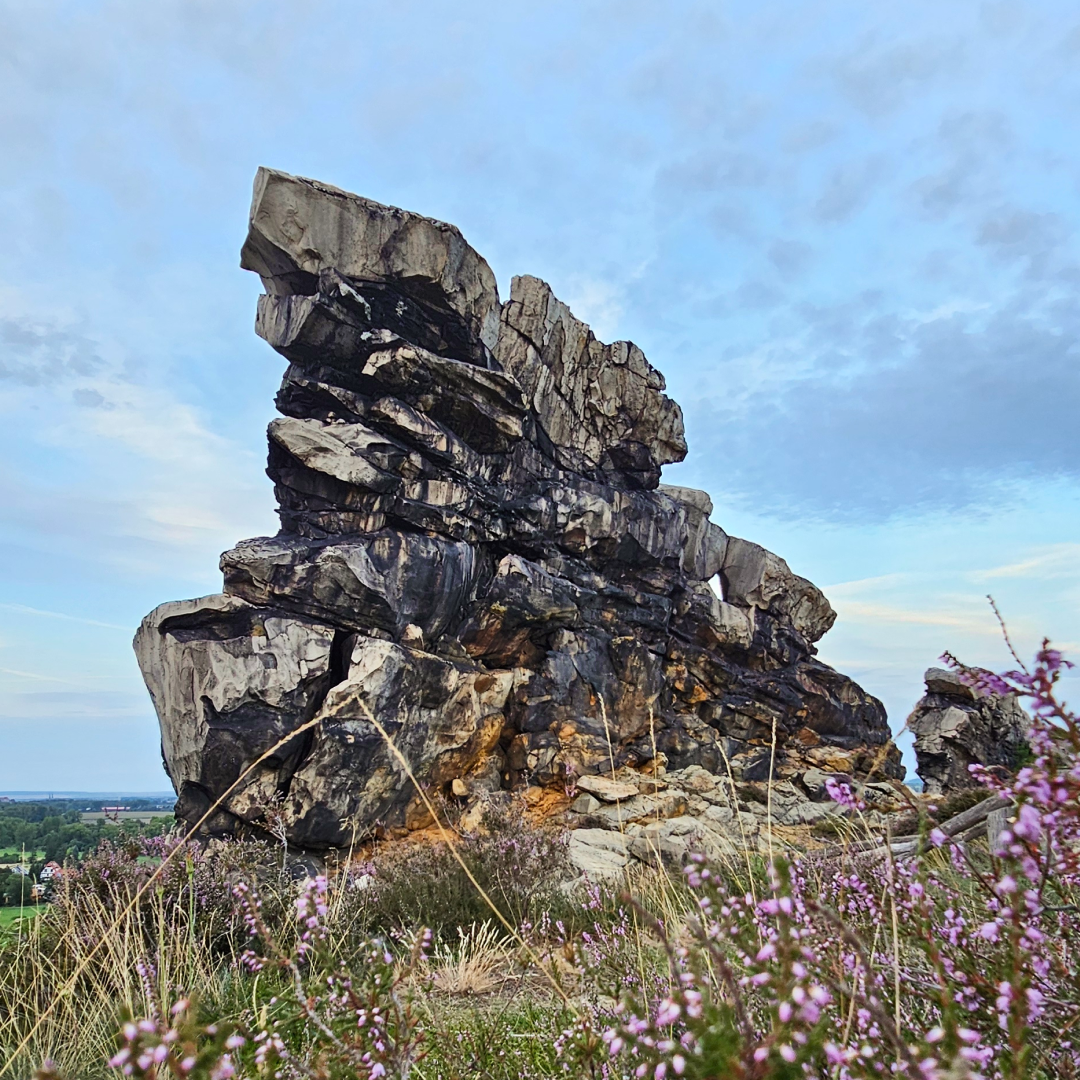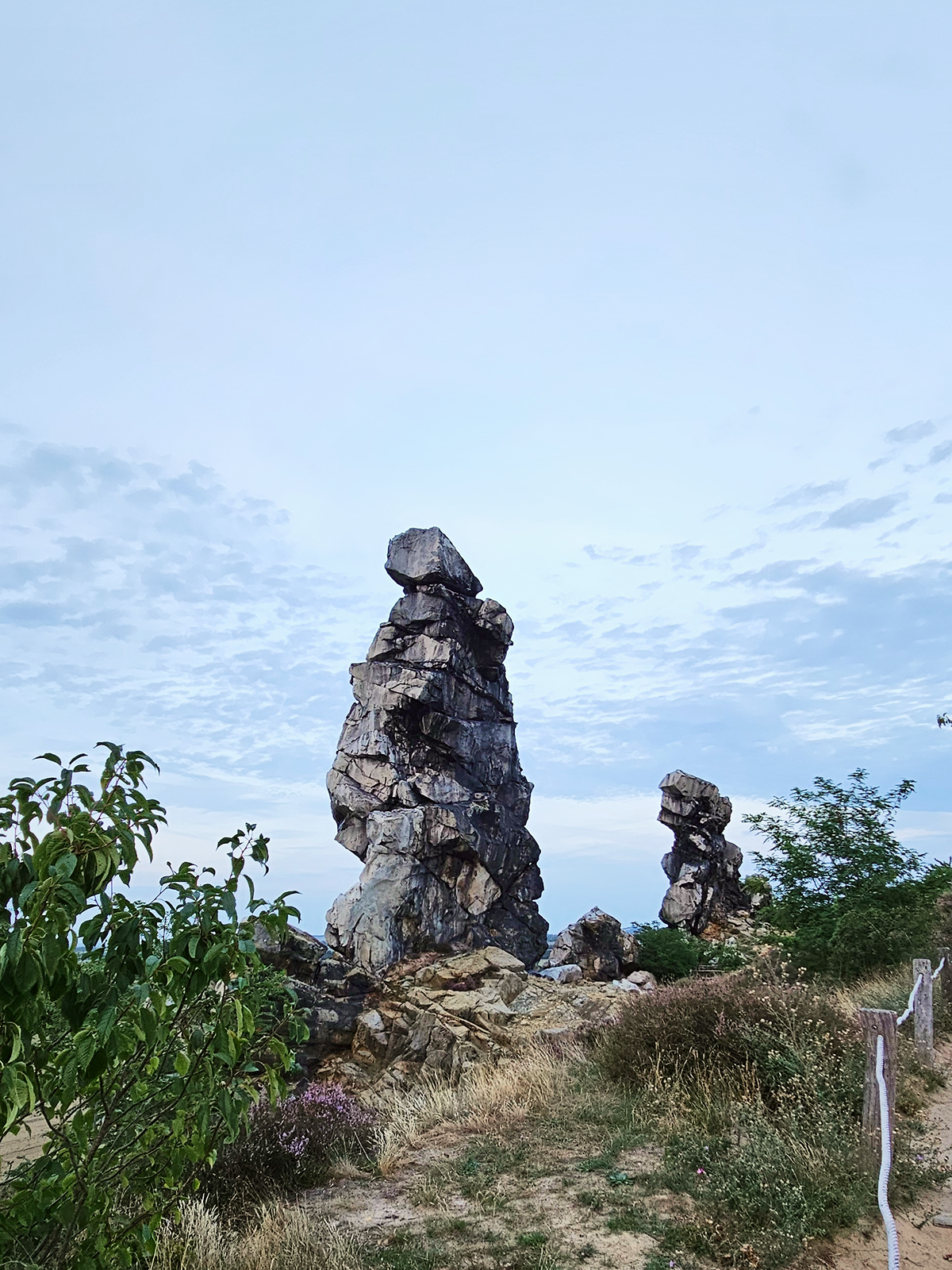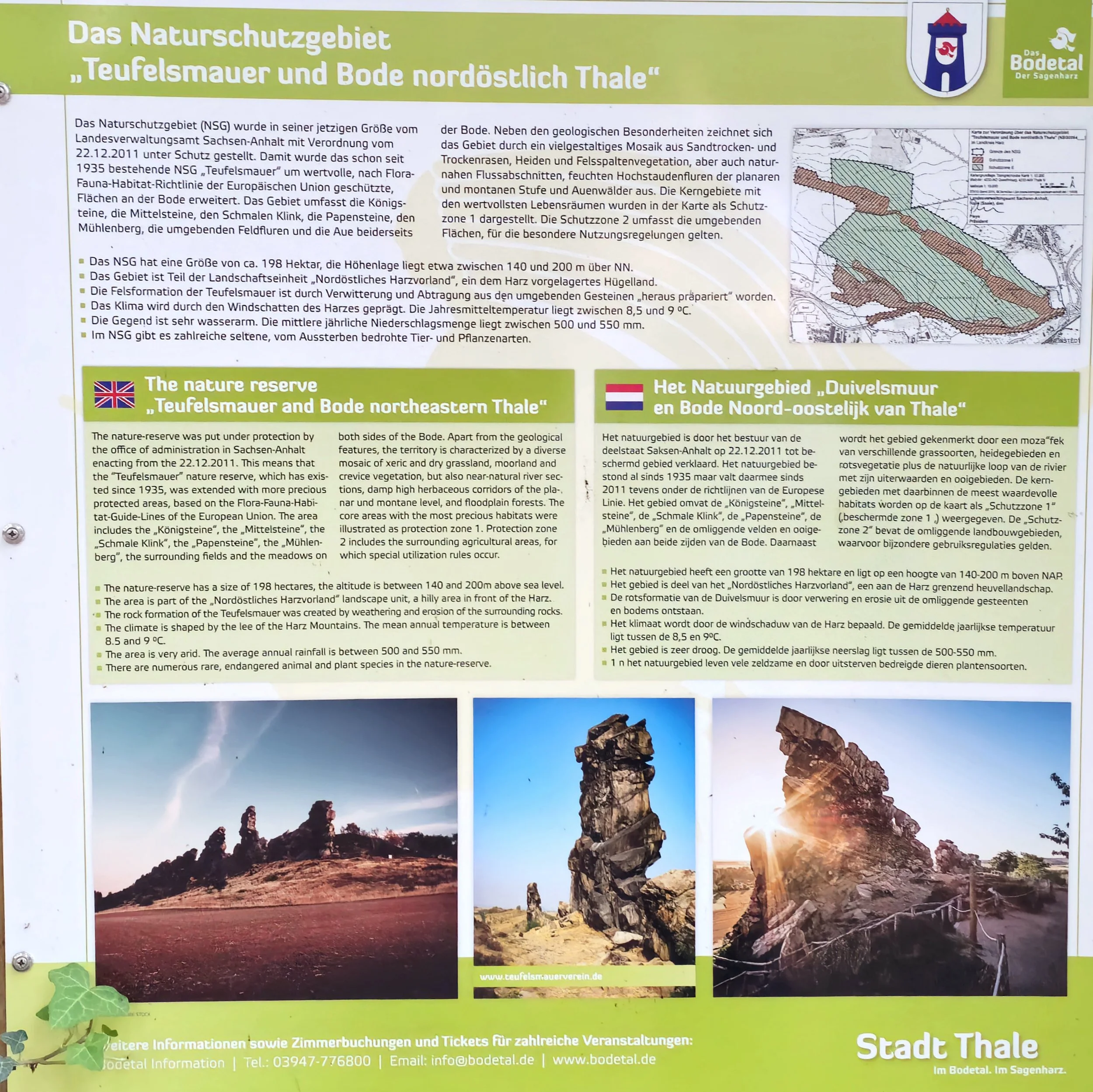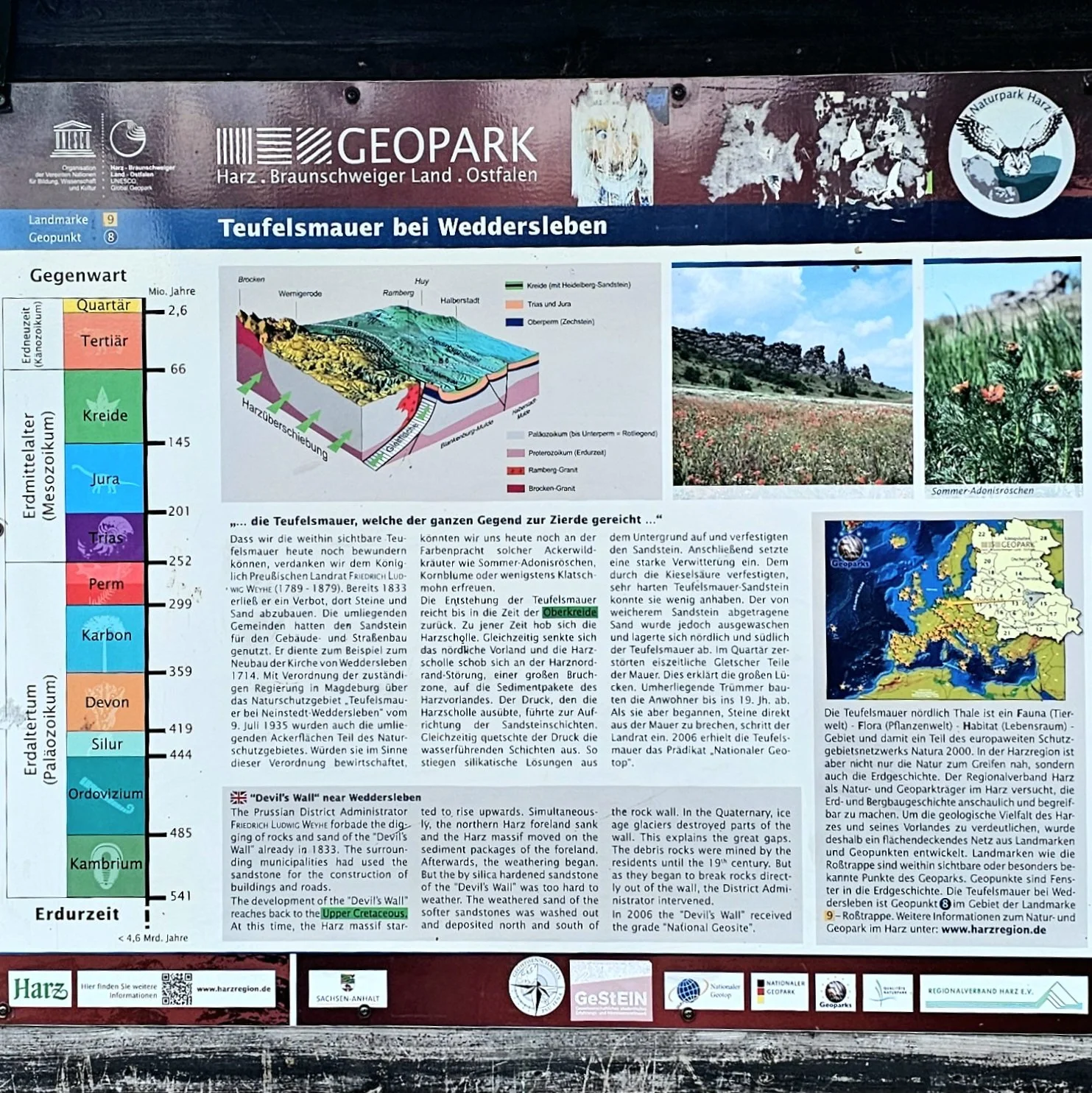Harz Legends: The Königstein at the Devil’s Wall
The ‘Großmutter’ stone of the ‘Königstein’ rock formation of the Devil´s Wall
The Harz Mountains are full of myths, hidden places, and fairytale landscapes.
One of the most striking natural landmarks is the Devil’s Wall, or Teufelsmauer (as it is called in german): a sandstone ridge that stretches for several kilometers along the northern edge of the Harz.
One of the most famous parts of this formation is the Königstein near Weddersleben, a dramatic, walllike rock formation noticeable even from a distance.
What is the Devil’s Wall?
The Devil’s Wall is a long series of jagged sandstone cliffs that have been formed by tectonic uplift and erosionhard about 85 to 65 million years ago during the Cretaceous period.
The formation stretches from Ballenstedt in the southeast via Weddersleben and Rieder to Blankenburg in the northwest, covering around 20 kilometres.
Since 2006 it has even been designated a national geotope and belongs to the UNESCO Geopark Harz – Braunschweiger Land – Östliches Harzvorland.
Parts of it have been protected since 1935 and count among the oldest nature reserves in Germany.
The most famous spots of the Devil´s wall are: the Königstein, the Mittelsteine, and the Hamburger Wappen.
The ‘Königstein’
The Königstein is a dramatic walllike outcrop north of the Bode river between Weddersleben and Neinstedt, stretching for roughly 500 metres northwest to southeast. At its western end stands the prominent Teufel (Devil) or West Tower. Further along rises the Adlerfelsen (Eagle Rock), the highest point of the Königstein. The formation includes other named rock features like Großmutter (Grandmother) and the Lange Wand (Long Wall).
The name ‘Königstein’ descends from Kehnstein, historically meaning “proclamation stone.” Historic visitors include Goethe, who climbed the Königstein in 1784. A ‘Goethe Stone’ on the south side commemorates that visit.
While geology explains its origins, the people of the medieval Harz had their own story on how this wall had been created.
The Legends of the Devil´s Wall: The Devil´s Bet
According to legend, the Devil wanted to claim the fertile Harz lands for himself. So he made a wager with God: if the Devil could build a wall across the region in just one single night, before the first rooster crowed, the land would be his.
Working feverishly, the Devil almost succeeded, but a clever farmer’s wife tricked him by making her rooster crow early. Furious at being cheated, he smashed his unfinished wall to pieces.
The scattered cliffs of the Devil’s Wall are told to be the remains of this unfinished wall.
The Devil´s bet' (AI generated)
Visiting the Königstein
Today, the Königstein is a popular hiking destination. The trail runs along the south side and includes wooden walkways and platforms for safe and accessible viewing. It also includes Stamp No. 188 of the Harzer Wandernadel, a beloved regional system that rewards hikers at specific points with stamps (more details on that in an upcoming post).
To reach the rock itself, visitors must climb several flights of steps. The access is therefore not barrier-free, but it is manageable also for untrained hikers. Dogs, even small ones, can usually join without difficulty – as long as they are reasonably fit. At the foot of the stairs, you’ll find an information board that even includes a short English summary for international visitors.
Explanation board: About the nature-reserve
Explanation board: The geological formation of the Devil´s Wall
Practical details:
Entrance: Free of charge
Opening hours: Technically open year-round, 24/7
Lighting: The paths are not illuminated, so visits should be limited to daylight hours. If you plan to stay for sunset (very popular time for photography) be sure to bring a flashlight for the way back.
Dogs: Allowed, but must be kept on a leash.
Stay on the marked trail: It’s important to stay on the designated path to help protect the local plants and wildlife as this area is part of a official nature-reserve.
How to get there:
I’d recommend going by car, as the Devil’s Wall is located in the countryside outside of town. Traveling by public transport is possible, but it’s a bit more challenging.
Option 01: By Car
Parking: Available at the ‘Teufelsmauer’ parking lot near Weddersleben (see map).
Enter either ‘Parkplatz Teufelsmauer’ ‘ or the official adress (Quedlinburger Str. 13, 06502 Thale) into your navigation system to get there.
A small gate near the parking lot marks the entrance to the path leading up to the Königstein.Parking fees: €1 for the first hour, €2 for each additional hour.
Tip: Bring coins for the parking machine, as many machines in the region don’t accept cards yet.
Option 02: By Public Transport
Example route from Wernigerode main station:
Variant 01:
1. Take the R21 train (direction: Magdeburg) to Quedlinburg, with one transfer in Halberstadt.
2. From Quedlinburg, take Bus 251 (platform 9; direction: Thale) and get off after 11 stops at ‘Weddersleben Teufelsmauer, Thale.’
(The bus stop is right across to the mentioned parking lot, where you´ll also find the entrance to the path to Teufelsmauer.)
Variant 02:
1. Take Bus 250 (platform 3; direction: Thale) and get off after 28 stops at ‘Kahlenbergstr., Thale’
2. Take Bus 251 (platform 6; direction: Quedlinburg) and get off after 8 stops at ‘Weddersleben Teufelsmauer, Thale.’
Finding connections from other locations:
Google Maps does not always display accurate public transport options in this area. Instead, use the Deutsche Bahn website or app to find the best connection for your starting point (the service supports multiple languages).Buying tickets:
You’ll need to buy separate tickets for the train and the bus, as there isn’t a single ticket that covers the entire journey.
Train tickets can be purchased from the ticket machines at the station platforms. These usually accept both cash and card payments.
Bus tickets are typically bought directly from the driver and are usually cash-only, though more and more buses also offer card payments. Tell the driver your destination (Weddersleben, Teufelsmauer) and they’ll let you know the price. If you pay with cash try to avoid paying with large notes (for example, paying €3 with a €50 bill), as the driver may not accept it and you could be refused boarding.
Follow the Stories
This legend is part of my Folklore Friday series, where I share myths and legends about the Harz Mountains on a regular basis. Follow me on Instagram @harz.unfiltered for the full series, hidden places and local stories brought to life.







